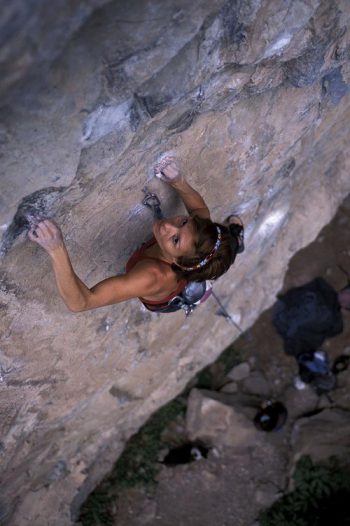When my index and middle fingers latched the tiny limestone hold to my right, a tidal wave of panic washed over me. A man was screaming; while the hold, free of climbing chalk, was delicate, his shrieks were overpowering. “Noooo! No, no, no, stop,” he yelled, standing about 20 feet below me on the ground. Had a rock knocked my belayer unconscious? Was my knot untied? I grabbed a nearby piece of gear and clipped myself in so I could safely assess the situation.

I asked what was wrong. “That’s not how you do that section,” said the guy, lean, lanky and long-limbed, about six-feet tall. “No one uses that hold.”
No one meaning, not him or people his size.
This was nearly 20 years ago, when there were not many women, and virtually no kids, climbing. The hold that lanky-loud-and-concerned-guy used, along with the majority-male climbing population, was far out of my reach. I stand a hair over 5′ tall, so I had become accustomed to using whatever the rock had to offer to make my way between well-used, chalky holds. My sequences were often far more complicated than taller climbers, but more interesting to execute. The kind of movement that made people on the ground go, “Oh cool, look at that.”
The route, Beer Run, was, according to the guidebook for Rifle Canyon in Colorado, known for its difficult finish, a series of reachy moves with big fall potential. Still, I felt confident I could onsight the route, meaning to climb successfully, from bottom to top without falling or resting on gear on the first attempt. And, without any information about the route in advance or while climbing.
Climbing is about problem-solving. Climbers default to their strengths. When that doesn’t work, we obsess over making a weakness into a strength. We try, we fall, we train, we return to the route to try again. When one climber figures out a new way to climb a route, others follow suit. New sequences open up new possibilities that evolve into an alternative.
Until a few weeks ago, in business and life, we were all lanky-limbed climbers, making our way using the “approved” sequences. But in the age of COVID-19, we’re suddenly 5′ tall and climbing our way to the top of a reachy route with big fall potential. But, fortunately, the rest of the world is like the most patient and safe belayer on the planet.
I’ve listened to friends and peers who are far more comfortable in real life than on-screen. Things like live streaming, social visibility makes a lot of people, myself included, cringe. But “Stay at Home” is a collective experience, and patience is at an all-time high. So now is the perfect time to explore the scary unknown. Since we are in this together, people are holding space for one another and the speed bumps of our first Zoom-hosted experience or tripod tumble during our inaugural Instagram Live.
At this time, not connecting via live stream platforms is a lost opportunity for many reasons. One to focus on is you may be forgoing the discovery of a new avenue to reach your community/customers that will last after this is over. Because eventually, it will be over.
A few tips and articles to up your social connection game.
1. Be Social
Now is the time your clients/customers/community want to hear from you. Be supportive and offer a way for people to feel less isolated, whether it’s providing helpful tips to get them through this period or creating fun community connections through online fitness classes or hosted happy hours. Some great examples can be found here.
2. Zoom
To stay connected in business and socially, the world is moving to places like Zoom, whose blog is a super helpful resource for how to execute experiences or manage your team. You can host Zoom meetings, workshops, or yoga classes; the opportunities are unlimited. Click here.
3. IG Live
Even before COVID-19, HootSuite reported that 82 percent of audiences would rather watch a live stream than see a social media post. And brands and individuals are having success. This article on HootSuite shows how one facialist took to Instagram Live to offer guided facials. She booked 36 virtual consults as a result. As a consultant or brand, consider a live Q&As, talk, or a sneak-peek at your process. For three easy steps to go live on IG, click here.
4. Set the Stage
If you’re like me and cringe when you see a camera, this is important. Set up your desk and computer’s camera, so you have a nice backdrop for meetings. Test out your environment in advance. Avoid having your camera facing a window or lamp. Check the angle and height of the camera by opening up Facetime or whatever app you are using so you can put your best face forward.
That day in Rifle Canyon, I lowered to the ground and decided I would attempt the route again the next day. On my first try, I climbed to the anchors without falling. It turns out the top section wasn’t as bad as the guidebook suggested. In climbing and life, that’s usually the case.
So remember, when you give yourself the chance to get out of your comfort zone on social or live streaming, you may just make a few people say, “Oh cool, look at that.”
